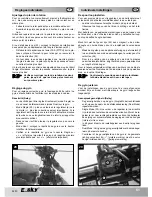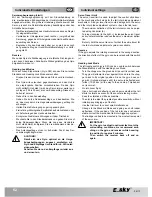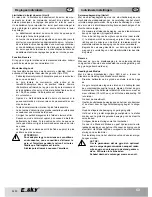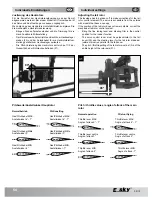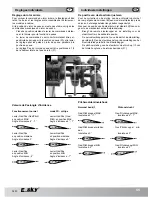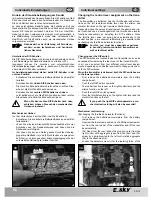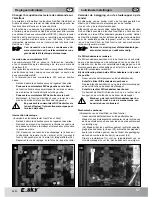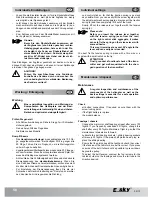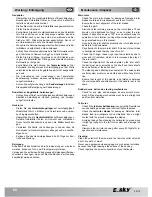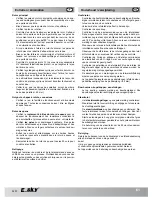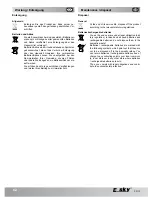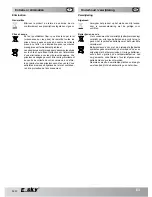
05/10
50
Individuelle Einstellungen
Individual settings
Einstellen des Spurlaufes
Für ein präzises Steuer- und Flugverhalten des Helikopters
muss sichergestellt sein, dass beide Rotorblätter exakt in einer
Ebene laufen.
Lassen Sie den Rotor drehen, während das Modell am Bo-
den steht.
Betrachten Sie die Blattspitzen in Richtung der Rotations-
ebene.
An Hand der farbigen Markierungen an den Blattspitzen können
Sie erkennen, ob sich beide Blätter am selben Umlaufpunkt in
gleicher Höhe befinden.
Sollte dies nicht der Fall sein (26), korrigieren Sie die Umlaufhöhe
beider
Blätter über eine Verstellung des Anstellwinkels (27).
Lösen Sie den Kugelkopf der Pitchanlenkung an der Taumel-
scheibe und drehen Sie diesen, um das Anlenkgestänge zu
verlängern oder einzukürzen (28).
Eine Drehung im Uhrzeigersinn erhöht den Anstellwinkel,
das Blatt bekommt mehr Auftrieb und läuft höher.
Eine Drehung gegen den Uhrzeigersinn vermindert den An-
stellwinkel und damit den Auftrieb, das Blatt läuft niedriger.
Überprüfen und korrigieren Sie den Spurlauf an
beiden Rotorblättern solange, bis beide Blätter
exakt in einer Ebene laufen.
Justierung des Gyro
Für die Einstellungen am Gyro muss der Rumpf abgenommen
werden! Bei einem Modell mit Trainerhaube ist das Gyro von
aussen zugänglich.
Ansprechempfindlichkeit (Delay)
Die Empfindlichkeit kann am Gyro direkt (Single Mode) bzw.
über einen Kanal der Fernsteuerung (Dual Mode) eingestellt
werden.
Single Mode (29):
Je weiter Sie den Regler (a) nach rechts
(+) drehen, um so stärker fallen die Korrekturen aus. Wird
der Regler zu weit nach rechts gedreht, neigt der Hubschrau-
ber zu Pendelbewegungen um die Hochachse (Rotorwelle).
In diesem Fall drehen Sie den Einstellregler ein kleines Stück
nach links zurück.
Dual Mode:
Korrigieren Sie die Gyroempfindlichkeit mit dem
Drehregler am Fernsteuersender.
Prüfen Sie, ob sich die Empfindlichkeit des Gyro in die rich-
tige Richtung ändert. Bei „+“ (größere Wirkung) muss das
Servo heftiger ausschlagen als bei „-“ (geringere Wirkung).
-
-
-
-
-
-
-
-
-
-
Setting the pitch
For a precise control and flight behaviour of the helicopter, both
the rotor blades must run in the same plane.
Let the rotor turn while allowing the model to stand on the
ground.
Observe the tips in the direction of rotation.
On the basis of the colour markings on the tips, you can make
out whether both the blades are at the same circulation point at
the same height.
If not (22), adjust the circulation height of both the blades by
adjusting the angle of attack (23).
Loosen the ball head of the pitch control on the swash plate
and turn it to extend or shorten the steering linkage (24).
If you turn it in the clockwise direction, the angle of attack
increases, the blade gets more lift and runs at a greater
height.
On the other hand, if you turn it in the anti-clockwise direc-
tion, the angle of attack decreases and thereby also the lift,
because of which the blade runs at a lower height.
Check and correct the pitch on both the rotor
blades till both the blades are in one plane.
Adjusting the gyro
The fuselage has to be taken off to make adjustments on the
gyro. The gyro is accessible from the outside with models that
have a canopy.
Response Sensitivity (Delay)
The sensitivity can be adjusted on the gyro directly (Single
Mode) or via a channel in the remote-control (dual mode).
Single Mode (25): The further you turn Controller (a) to the
right (+) the stronger the corrections will be. If the controller
is turned too far to the right, the helicopter will be prone to
swinging motions about its vertical axis (rotor shaft).
In such a case, turn the adjuster back a bit to the left.
Dual Mode: Use the rotary controller on the remote-control
transmitter to correct the gyro sensitivity.
Check whether the gyro changes in the correct direction.
With „+“ (greater effect), the servo should deflect more shar-
ply than with „-“ (smaller effect).
-
-
-
-
-
-
-
-
-
-
26
27
29
28
Содержание KING 3
Страница 21: ...05 10 21 5...
Страница 79: ...Pi ces de rechange Onderdelen 05 10 79...
















